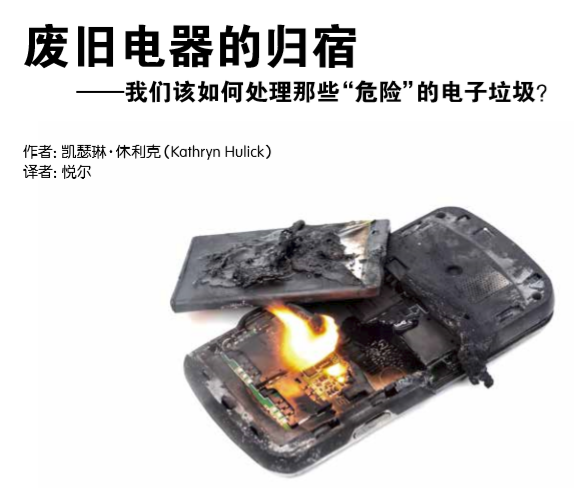This article appears in the April 2020 issue of Front Vision, an educational Chinese-language magazine for kids. It is reproduced here with permission. Read about my other articles for Front Vision here.

Unwanted Electronics: What should we do with old, broken electronic devices?
by Kathryn Hulick
On a winter morning in New York City in 2017, workers tossed a duct-taped box into a garbage truck. When the truck crushed the box, it exploded. The quick-thinking workers stopped the compactor, retrieved the burning box, and tossed it in a puddle, putting out the fire. What had been inside that box? It wasn’t full of explosives. It held a lithium-ion battery. These power many electronic gadgets, including cell phones, laptops, watches, toothbrushes, remote-controlled toys, and more. If the batteries get punctured or crushed, they easily catch fire. These fires regularly erupt in trucks and at waste and recycling facilities around the world. The Clean Center garbage disposal facility in Tokyo, Japan, had to call firefighters six times in one year to respond to battery fires. In 2020, a fire destroyed a multimillion dollar recycling plant in Apalachin, New York. The company believes a cell phone battery sparked the blaze.
Batteries and electronics don’t belong in the trash. They also don’t belong in a mixed-recycling bin with paper, plastic, metal, and glass. In addition to posing a serious fire danger, an electronic device that ends up at a typical recycling facility won’t get recycled. Lynn Rubinstein, executive director of the Northeast Recycling Council (NERC) says:“It’s not what they are set up for, so it’s going to get thrown out, which is a terrible waste.”
Filled with wonderful things
Electronics can only be properly processed at one of these places: computers, laptops, monitors, keyboards, mice, power cables, televisions, game players, and “anything that is thinking,” says Rubinstein. She means anything that has a computer chip or circuit board somewhere.
These are complex devices with many parts. Rubinstein says that just about everything in these devices can be recycled or reused. “There are all sorts of wonderful things in there,” she says. The first step is to safely remove any batteries. These go to separate recyclers who separate the metal exterior of a battery from the chemicals inside. The metal goes to a scrap metal facility to get melted down and reused, while the chemical “guts” can usually be collected and treated for use in new batteries. Recycled batteries can also become asphalt, golf clubs, and more.
The plastic casing and metal wires and solder from an electronic device can be melted down and used to manufacture new items. The most complex parts——computer chips and circuit boards contain many heavy metals( such as lead, beryllium, and cadmium )as well as rare-earth metals, (like lanthanum, yttrium, gadolinium) or any rare elements. The metals are an essential component in everything from computing technology to airplanes, cars, power plants, and solar panels. However, these aren’t easy to extract from old electronics either.
Laziness and Ignorance
Unfortunately, according to a 2019 UN report, only 20 percent of the world’s electronic waste ends up in the right place—a formal recycling facility that follows international standards for safe recovery of the materials in electronics. And the amount of e-waste produced worldwide each year comes to fifty million tonnes—the weight of all the passenger airplanes ever made.
Why is the electronics recycling rate so low? One reason is cost. Though the plastic, metal, rare-earth metals, and other raw materials in an electronic device all have value, the time and effort it takes to separate all these things costs more than the materials are worth. Someone has to pay for this processing. Depending on where you live, this cost may fall on the government, the manufacturer of the device, or the consumer.
Two other important factors are “laziness and lack of awareness,” says Rubinstein. Even if you already know that electronics shouldn’t go
in a regular trash can or recycling bin, you may have no idea where these items should go. And there’s no easy answer.
In some countries, including Japan and most of Europe, relevant systems have been put in place to recycle electronics. When people purchase a new electronic item, they usually have to pay a fee that will cover recycling costs. In the US, only one state— California—charges a fee like this for electronics purchases. In twenty-five other US states, electronics manufacturers are responsible for paying for the collection and recycling of their customers’ old items.
If you are in the US and you have a gadget to get rid of, you may have to take the item to a drop-off location or mail it to a recycling facility or to the manufacturer. The website Call2Recycle.org can help you find a place to recycle batteries. And Earth911.org offers information on how to recycle just about anything, including electronics.
Informal Recycling
Even if you do the right thing and send your old gaming system or television off to be recycled, the item may not end up in the right place. In some parts of the world, people desperate for income will do whatever it takes to glean materials from electronic waste. “What they are trying to do is get precious metals out of things in the simplest and quickest way, often using kids to do it because they are small,” says Kelley Keogh, cofounder of Greeneye Partners, a company that makes sure electronics recyclers follow safety standards. These informal recycling sites typically rely on scary, unsafe methods. For example, workers may burn items over open fires in order to recover the metals as they melt. “Oftentimes we will see a 55-gallon drum with a fire in it with a grate on top,” says Keogh. A circuit board sits on top of the grate like a hamburger on a grill. As it burns, the smoke spreads harmful toxins, including dioxin, lead, beryllium, and cadmium, into the surrounding air. Any plastics or other leftover components may get dumped onto the ground and end up polluting the water. People exposed to toxins from these sites may get sick with cancer and other illnesses at a higher rate than the general population.
At a formal, certified recycling facility or metal smelter, workers wear masks and gloves. Air collection technology filters the smoke and separates out toxins. Meanwhile, the facility and the government monitor the air to make sure the filters are working. Also, a landfill that takes electronic waste should be lined and closed off from any water sources. These measures help prevent the release of poisons into the air or water. Ten years ago, many informal electronic recycling sites existed in China, which once processed 70 percent of the world’s e-waste. The Chinese government has cracked down on these sites, though.
Recyclable Design
We all have to help make sure our electronic waste goes to formal, certified recycling facilities——We can throw away less of it. To do this, we should use our devices longer, repairing them when they break instead of replacing them. “A very large amount of raw material and human effort goes into making these things. We want to get the maximum utility out,” says Kyle Wiens, cofounder of the company iFixit. His team takes apart new electronics to figure out how they work, and then creates repair manuals and do-it-yourself repair kits. A repair is almost always cheaper than a new item. And the repair also saves all the resources that would go into making a new gadget, with no costly recycling process required.
Unfortunately, most electronics manufacturers today practice something called planned obsolescence. They don’t plan for their customers to use their products for a long time. So they don’t make spare parts or repair manuals. Instead, they encourage customers to buy a new model every
few years. “They want us on this treadmill where we buy more products from them regularly,” says Wiens. For example, Apple regularly comes out with brand new models of its iPhone, iPad, and other products and encourages customers to upgrade. The company does not make it easy to replace batteries or add new features to old models. Customers are only supposed to take their gadgets to an Apple Genius Bar for repairs. The company actually invents its own screws to make it more difficult for others to repair their products!
If you’ve got the right screwdriver (Wiens has reverse-engineered ones for Apple products), then replacing a phone’s battery really isn’t that hard, he says. You unscrew the screen and use a suction cup to lift it off. Then you remove a few more screws and carefully loosen some glue on the battery. “Then you glue the new battery in place and put it back together,” says Wiens. “For most smart phones it is less than an hour of work.” Plus there’s the satisfaction in knowing that you fixed something yourself.
Items that are easy to repair are also much easier to recycle since the first step in recycling anything is to separate it into all its component parts. To support recycling, companies should design their products for a long-life span, says Wiens. “They should make the parts and information available so people can fix them.” The Right to Repair movement is attempting to pass laws that would require manufacturers to do these things.
The European Union already has a law supports the reuse and recycling of electronics. The Waste Electrical and Electronic Equipment (WEEE) directive mandates that only 20 percent of the weight of an electronic device may go to a landfill. The rest has to be repaired, reused, or recycled— all processes that require taking the item apart. Electronics manufacturers are responsible for making sure their old products get reused or recycled. So they have an incentive to design products that are easier to take apart and recycle. For example, they may use snap-fit fasteners instead of screws since they separate more easily. And they may weld plastic instead of gluing it since glued plastics may be too contaminated to recycle.
In the US, the EPA runs a program that gives awards to companies that make it easy to repair or recycle their electronic products responsibly. The company Dell won a champion award in 2019 for its success in recycling hard drives. In a test, the company recovered magnets containing rareearth metals from old hard drives that customers had returned. It then reused the magnets in new hard drives. This test saved 300 kg of material from going to landfills. In the future, the process could rescue as much as 3600 kg of material per year.
If you have an electronic item that you no longer use, the first thing you should do is try to fix it or find someone who wants to use it. If the item can’t be used, then you should find a recycler who will make use of all the parts of it responsibly. And you should encourage your local and national governments to pass laws that support safe recycling of electronics. We all have a part to play in reducing electronic waste.

